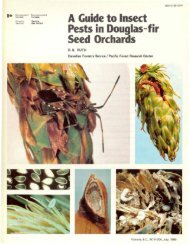A spatial, climate-determined risk rating for Scleroderris disease of ...
A spatial, climate-determined risk rating for Scleroderris disease of ...
A spatial, climate-determined risk rating for Scleroderris disease of ...
Create successful ePaper yourself
Turn your PDF publications into a flip-book with our unique Google optimized e-Paper software.
1398<br />
A <strong>spatial</strong>, <strong>climate</strong>-<strong>determined</strong> <strong>risk</strong> <strong>rating</strong> <strong>for</strong><br />
<strong>Scleroderris</strong> <strong>disease</strong> <strong>of</strong> pines in Ontario<br />
L.A. Venier, A.A Hopkin, D.W. McKenney, and Y. Wang<br />
Abstract: We used historical distribution data <strong>of</strong> <strong>Scleroderris</strong> <strong>disease</strong> (caused by the fungus Gremmeniella abietina var.<br />
abietina (Lagerb.) Morelet) in Ontario to model its probability <strong>of</strong> occurrence as a function <strong>of</strong> <strong>climate</strong> factors. A logistic<br />
regression model <strong>of</strong> the probability <strong>of</strong> occurrence as a function <strong>of</strong> the mean temperature <strong>of</strong> the coldest quarter and the<br />
precipitation <strong>of</strong> the coldest quarter was a very good fit. The concordance (index <strong>of</strong> classification accuracy) <strong>of</strong> the<br />
model was 84%. We subsampled the data repeatedly, generated new parameter estimates, and tested the predictions<br />
against data not included in the model. Classification accuracy was similar <strong>for</strong> each subsample model; there<strong>for</strong>e, we<br />
concluded that the final model is stable. Gridded estimates <strong>of</strong> the <strong>climate</strong> variables were used to <strong>spatial</strong>ly extend the<br />
two-variable logistic regression model and produce a probability <strong>of</strong> occurrence map <strong>for</strong> <strong>Scleroderris</strong> <strong>disease</strong> across<br />
Ontario. The predicted map <strong>of</strong> probability <strong>of</strong> occurrence fits well with the map <strong>of</strong> the observed locations <strong>of</strong> the<br />
<strong>disease</strong>. These results lend credence to previous work that suggests that distribution <strong>of</strong> <strong>Scleroderris</strong> <strong>disease</strong> is strongly<br />
influenced by <strong>climate</strong>. The classification results also suggest that this model is a useful tool <strong>for</strong> assessing the <strong>risk</strong> <strong>of</strong><br />
<strong>Scleroderris</strong> <strong>disease</strong> throughout Ontario.<br />
Résumé : Nous avons utilisé des données retraçant l’historique de la distribution du chancre scléroderrien, causé par le<br />
champignon Gremmeniella abietina var. abietina (Lagerb.) Morelet, en Ontario pour modéliser la probabilité que la<br />
maladie se développe en fonction des facteurs climatiques. Un modèle de régression logistique de la probabilité que la<br />
maladie se développe en fonction de la température moyenne et de la précipitation des 3 mois les plus froids était très<br />
adéquat. La concordance (l’indice de précision des prédictions) du modèle était de 84%. Nous avons utilisé des<br />
sous-échantillons des données de façon répétitive pour générer de nouvelles estimations des paramètres et nous avons<br />
testé les prédictions avec des données non incluses dans le modèle. La précision des prédictions était semblable pour<br />
chaque modèle tiré des sous-échantillons de telle sorte que nous avons conclu que le modèle final était stable. Les<br />
variables climatiques estimées pour chaque cellule d’un système de quadrillage ont été utilisées pour appliquer de<br />
façon <strong>spatial</strong>e le modèle de régression logistique à deux variables et produire une carte indiquant la probabilité que le<br />
chancre scléroderrien se développe, partout en Ontario. La carte ainsi obtenue correspond bien avec la carte qui<br />
indique les endroits où la maladie a été observée. Ces résultats donnent de la crédibilité aux travaux antérieurs qui<br />
suggèrent que la distribution du chancre scléroderrien est <strong>for</strong>tement influencée par les conditions climatiques. Le<br />
résultat des prédictions suggère également que ce modèle est un outil utile pour évaluer les risques que le chancre<br />
scléroderrien survienne, partout en Ontario.<br />
[Traduit par la rédaction] Venier et al. 1404<br />
<strong>Scleroderris</strong> <strong>disease</strong>, caused by the fungus Gremmeniella<br />
abietina (Lagerb.) Morelet var. abietina, has been regarded<br />
as a major pest <strong>of</strong> pine species in North America <strong>for</strong> more<br />
than 30 years (Laflamme 1993). Two distinct strains <strong>of</strong> the<br />
fungus are recognized as being damaging to pines in North<br />
America; these are referred to as the North American (NA)<br />
and European (EU) races. Both races are morphologically<br />
similar and have similar ecological requirements. The two<br />
Received December 22, 1997. Accepted June 30, 1998.<br />
L.A. Venier, 1 A.A Hopkin, and D.W. McKenney. Canadian<br />
Forest Service, 1219 Queen St. East, Sault Ste. Marie, ON<br />
P6A 3V5, Canada. e-mail: lvenier@nrcan.gc.ca,<br />
ahopkin@nrcan.gc.ca, dmckenney@nrcan.gc.ca<br />
Y. Wang. Canadian Forest Service, Northern Forestry Centre,<br />
5320 - 122nd Street, Edmonton, AB T6H 3S5, Canada.<br />
e-mail: ywang@nrcan.gc.ca<br />
1 Author to whom all correspondence should be addressed.<br />
races can only be distinquished on the basis <strong>of</strong> biochemical<br />
tests (Bernier et al. 1994). Either race will cause mortality to<br />
pine trees less than 1minheight and cause cankering and<br />
loss <strong>of</strong> merchantable volume to trees less than 3.5 m in<br />
height (Dorworth 1976).<br />
The NA race, believed to be native to the continent<br />
(Laflamme 1993) occurs over the range <strong>of</strong> pines in Ontario<br />
(Sippell et al. 1966; Hopkin and McKenney 1995), primarily<br />
on red pine (Pinus resinosa Ait.) and jack pine (P. banksiana<br />
Lamb.). The <strong>disease</strong> has been recorded as causing cankering<br />
and mortality to jack pine and red pine seedlings and has<br />
been associated with numerous planting failures in Ontario<br />
since the 1950s (Punter 1967; Dorworth 1970). While the<br />
NA strain can kill or damage younger trees it does not cause<br />
significant damage to trees over 2minheight, although it<br />
will attack lower branches. The EU race, which has been<br />
considered a damaging <strong>disease</strong> <strong>of</strong> pines in Europe <strong>for</strong> at<br />
least 100 years (Donaubauer 1972), was first discovered in<br />
North America in 1975 in New York State (Skilling 1977)<br />
where it caused mortality to several thousand hectares <strong>of</strong><br />
Can. J. For. Res. 28: 1398–1404 (1998) © 1998 NRC Canada
Venier et al. 1399<br />
semimature red and Scots pine (Pinus sylvestris L.). More<br />
recently it has caused extensive damage to red pine plantations<br />
in western Quebec (Laflamme and Lachance 1987).<br />
In Ontario, the EU race was first identified in 1985<br />
(Myren and Davis 1986) in south-central Ontario, but it has<br />
been restricted in its range through annual detection, followed<br />
by control ef<strong>for</strong>ts primarily consisting <strong>of</strong> pruning<br />
lower branches and burning <strong>of</strong> <strong>disease</strong>d material (Hopkin<br />
and Laflamme 1995). However, since 1991 the EU race has<br />
expanded its range in Ontario (Hopkin and McKenney<br />
1995). In Quebec where the <strong>disease</strong> has been present since<br />
1983, both races co-exist over much <strong>of</strong> the area where red<br />
pine is planted (Laflamme and Bussieres 1990; Laflamme<br />
1993). The <strong>disease</strong> is believed to be restricted in its southernmost<br />
distribution by <strong>climate</strong>. Marosy et al. (1989) suggested<br />
the fungus requires an incubation period <strong>of</strong> at least<br />
44 days <strong>of</strong> temperatures between –6 and 5°C after initial infection<br />
be<strong>for</strong>e <strong>disease</strong> symptoms are apparent. Karlman et<br />
al. (1994) also observed increasing <strong>disease</strong> incidence and severity<br />
in Sweden with increasing latitude, snow cover, and<br />
lower temperatures. In Ontario the <strong>disease</strong> has not been<br />
found below 44°30′N despite repeated surveys (Hopkin and<br />
McKenney 1995), strongly suggesting a relationship between<br />
the <strong>disease</strong> and <strong>climate</strong>. On this basis it should be<br />
possible to determine which areas have a <strong>climate</strong> that would<br />
be conducive to the <strong>disease</strong>. White pine blister rust<br />
(Cronartium ribicola J.C. Fisch.) is a <strong>disease</strong> affecting white<br />
pine (Pinus strobus L.) and is known to have temperature<br />
and moisture requirements <strong>for</strong> successful infection to occur<br />
(van Arsdel et al. 1956, 1961). On the basis <strong>of</strong> the known<br />
climatological and physiographic characters related to these<br />
requirements, van Arsdel (1961) developed hazard zones <strong>for</strong><br />
the Lake States area <strong>of</strong> the United States. This work has<br />
been used to define blister rust hazard zones <strong>for</strong> other areas<br />
including Ontario (Gross 1985).<br />
In this paper, we model the relationship between the probability<br />
<strong>of</strong> occurrence <strong>of</strong> <strong>Scleroderris</strong> <strong>disease</strong> and elements <strong>of</strong><br />
<strong>climate</strong> on a broad geographic scale. There is a correlation<br />
between occurrence and abundance <strong>for</strong> most organisms<br />
(Hergstrom and Niall 1990; Yamamura 1990; Venier and<br />
Fahrig 1996; Venier and Fahrig 1998); there<strong>for</strong>e, we expect<br />
the probability <strong>of</strong> occurrence to be a good estimate <strong>of</strong> <strong>risk</strong>.<br />
Evidence from the literature presented above suggests that<br />
<strong>climate</strong> is an important influence on the distribution <strong>of</strong> the<br />
<strong>disease</strong>. A model <strong>of</strong> <strong>Scleroderris</strong> <strong>disease</strong> distribution as a<br />
function <strong>of</strong> <strong>climate</strong> with a good fit and high classification<br />
accuracy should lend support to the idea <strong>of</strong> climatic influence<br />
and will also provide a means <strong>of</strong> predicting areas <strong>of</strong><br />
high <strong>risk</strong> <strong>for</strong> <strong>Scleroderris</strong> <strong>disease</strong>. Our principle objective is<br />
to generate a reliable <strong>spatial</strong> estimate <strong>of</strong> the occurrence <strong>of</strong><br />
the <strong>disease</strong>. There<strong>for</strong>e, we are limited to using explanatory<br />
variables <strong>for</strong> which we have <strong>spatial</strong> estimates <strong>for</strong> Ontario. A<br />
long-term data set <strong>of</strong> the distribution <strong>of</strong> the <strong>disease</strong> in Ontario<br />
is available because <strong>of</strong> the historic and ongoing monitoring<br />
<strong>of</strong> the <strong>disease</strong> by the Canadian Forest Service. We<br />
also have <strong>spatial</strong> estimates <strong>of</strong> <strong>climate</strong> <strong>for</strong> all <strong>of</strong> Ontario (with<br />
a 1-km resolution grid) derived from long-term mean<br />
monthly averages. Climate data in this <strong>for</strong>m allows us to attach<br />
<strong>climate</strong> estimates to the observations <strong>of</strong> presence and<br />
absence <strong>of</strong> the <strong>disease</strong>, as well as develop <strong>spatial</strong> predictions<br />
<strong>of</strong> the model across the province.<br />
Table 1. Climate variables used in analysis.<br />
Variable Description<br />
ANNTEMP Mean annual temperature<br />
MXRNG Maximum diurnal temperature range<br />
XTMPHT* Mean temperature <strong>of</strong> the hottest month<br />
XTMPCLDM Mean temperature <strong>of</strong> the coldest month<br />
XSNLRNG* Mean seasonal temperature ranges<br />
MXTMPHT Maximum temperature <strong>of</strong> the hottest month<br />
MNTMPCLD Minimum temperature <strong>of</strong> the coldest month<br />
ARNGTMP Annual range in temperature<br />
XTMPHTQ Mean temperature <strong>of</strong> the hottest quarter<br />
XTMPCLDQ* Mean temperature <strong>of</strong> the coldest quarter<br />
APRP* Annual precipitation<br />
PRPRNG Precipitation range<br />
SSNLT* Seasonal variation in precipitation<br />
PRPHTQ* Precipitation <strong>of</strong> the hottest quarter<br />
PRPCLDQ Precipitation <strong>of</strong> the coldest quarter<br />
STRTGRW* Julian day <strong>of</strong> start <strong>of</strong> the growing season<br />
ENDGRW* Julian day <strong>of</strong> end <strong>of</strong> the growing season<br />
DAYGRW Days in the growing season<br />
PRPP1 Total precipitation <strong>for</strong> period 1<br />
PRPP3 Total precipitation <strong>for</strong> period 3<br />
DAYGRWP3* Growing degree-days <strong>for</strong> period 3<br />
AMXTMP* Annual mean maximum temperature<br />
AMNTMP* Annual mean minimum temperature<br />
Note: The growing season starts on the last day <strong>of</strong> five consecutive<br />
days when the mean daily temperature is above 5°C (beginning no sooner<br />
than March 1 and ending by July 31). The growing season ends the first<br />
day from August 1 with a minimum temperature <strong>of</strong> less than –2°C. Period<br />
1 is 3 months prior to the growing season. Period 3 is the growing<br />
season. Variables retained in the backward stepwise selection procedure <strong>of</strong><br />
the logistic regression analysis are marked with aste<strong>risk</strong>.<br />
Disease distribution<br />
In<strong>for</strong>mation on the presence and absence <strong>of</strong> <strong>Scleroderris</strong> <strong>disease</strong><br />
(both North American and European races) was compiled from<br />
surveys conducted in Ontario by the Canadian Forest Service from<br />
1985 to 1993. Field technicians conducted aerial reconnaissance <strong>of</strong><br />
pine plantations, generally by fixed-wing aircraft, to locate infected<br />
plantations. The aerial surveys were conducted from May to<br />
early June, when symptoms were most visible, over townships containing<br />
pine plantations in south-central Ontario. Aerial surveys<br />
were followed by ground surveys. In northern regions where only<br />
the NA race is known to exist, only ground surveys were used. At<br />
each plantation visited, 500 trees were inspected along transects<br />
randomly distributed throughout the plantation. There were 1139<br />
pine plantations sampled across Ontario <strong>for</strong> presence or absence <strong>of</strong><br />
the <strong>disease</strong>, and samples were submitted <strong>for</strong> diagnostics <strong>for</strong> confirmation.<br />
There<strong>for</strong>e, the <strong>disease</strong> distribution data are recorded as binary<br />
data (presence or absence). At each plantation, the <strong>disease</strong><br />
was confirmed as present or absent by visual inspection followed<br />
by a laboratory confirmation using serological techniques (Dorworth<br />
and Krywienczyk 1975). The geographic location, to the<br />
nearest kilometre, was recorded <strong>for</strong> each plantation. More details<br />
<strong>of</strong> survey methodology and diagnostics are described by Hopkin<br />
and McKenney (1995).<br />
Climate data<br />
The <strong>climate</strong> data were interpolated from a network <strong>of</strong> 471<br />
weather stations in and around the province <strong>of</strong> Ontario. Mackey et<br />
© 1998 NRC Canada
1400 Can. J. For. Res. Vol. 28, 1998<br />
Table 2. Diagnostics from four logistic regression analyses.<br />
Diagnostics<br />
Backward<br />
stepwise selection<br />
(11 variables)<br />
al. (1996) generated mathematical <strong>climate</strong> surfaces <strong>for</strong> the province<br />
using the thin-plate smoothing-spline techniques <strong>of</strong> Hutchinson<br />
(1991). These monthly surfaces were created as a function <strong>of</strong><br />
latitude, longitude, and elevation to capture both <strong>spatial</strong> and temporal<br />
variations in lapse rates. Errors associated with the surfaces<br />
are approximately ±0.5°C <strong>for</strong> temperature related variables, and<br />
10–20 mm <strong>for</strong> precipitation.<br />
These surfaces enable us to append <strong>climate</strong> variables to<br />
georeferenced (latitude, longitude, elevation) historical field survey<br />
data. Also, the <strong>climate</strong> variables can be mapped by coupling the<br />
mathematical surfaces to a digital elevation model (a regular grid<br />
<strong>of</strong> latitude, longitude, and elevation representing the topography on<br />
an area; see Moore et al. 1991). A digital elevation model <strong>for</strong> Ontario<br />
has been developed based on the National Topographic Series<br />
1 : 250 000 digital topographic data resolved at a 1-km grid. Mathematical<br />
surfaces were developed <strong>for</strong> long-term mean monthly averages<br />
<strong>of</strong> minimum temperature, maximum temperature, and<br />
precipitation. Secondary <strong>climate</strong> variables, that are likely to reflect<br />
processes determining distributions <strong>of</strong> organisms, were derived<br />
from these primary surfaces (see Mackey et al. 1996 <strong>for</strong> further details<br />
on <strong>climate</strong> modelling).<br />
Analysis<br />
We used logistic regression analysis to examine the probability<br />
<strong>of</strong> occurrence <strong>of</strong> <strong>Scleroderris</strong> <strong>disease</strong> as a function <strong>of</strong> aspects <strong>of</strong><br />
temperature and precipitation. For each sample location where<br />
<strong>Scleroderris</strong> <strong>disease</strong> was confirmed as present or absent, we attached<br />
an estimate <strong>of</strong> each <strong>of</strong> the <strong>climate</strong> variables listed in<br />
Table 1. The severity <strong>of</strong> the <strong>disease</strong> was not considered as all plantations<br />
are at <strong>risk</strong> after the <strong>disease</strong> becomes established. We ran<br />
several different models. First, we used all <strong>climate</strong> variables in a<br />
backward stepwise selection procedure to identify the best possible<br />
predictability that could be derived from these explanatory variables<br />
using a criterion <strong>of</strong> α = 0.05 to remove a variable. Then we<br />
selected two variables (the mean temperature <strong>of</strong> the coldest quarter<br />
and the precipitation <strong>of</strong> the coldest quarter) that we anticipated<br />
would explain variance in the probability <strong>of</strong> occurrence based on<br />
our experience and on previously published work on the ecology<br />
<strong>of</strong> the <strong>disease</strong>. We compared these two models using concordance<br />
(an index <strong>of</strong> classification accuracy). We were attempting to identify<br />
the most parsimonious model without incurring a large loss in<br />
our ability to predict (based on classification). We then ran models<br />
<strong>for</strong> each <strong>of</strong> the two selected <strong>climate</strong> variables separately and compared<br />
the concordance with the two-variable model to evaluate the<br />
usefulness <strong>of</strong> these variables on their own. Once we identified our<br />
XTMPCLDQ<br />
PRPCLDQ<br />
XTMPCLDQ<br />
(mean temperature<br />
in coldest quarter)<br />
–2log L (intercept only) 1534.2 1534.2 1534.2 1534.2<br />
–2log L (intercept + covariates) 821.0 1089.9 1294.0 1520.9<br />
Chi-square <strong>for</strong> covariates 713.2 444.3 240.3 13.3<br />
df (model) 11 2 1 1<br />
P (model) 0.0001 0.0001 0.0001 0.0003<br />
Concordance (%) 91.4 84.4 74.0 57.6<br />
Best probability 0.46 0.40 0.34 0.40<br />
Sensitivity 85.6 76.8 60.8 56.7<br />
Specificity 83.6 77.9 66.6 64.1<br />
False negatives 22.3 30.1 45.1 48.6<br />
False positives 10.4 16.6 28.3 31.2<br />
PRPCLDQ<br />
(precipitation in<br />
coldest quarter)<br />
Note: There were 1139 observations in the data set: 457 observations <strong>of</strong> presence and 682 observations <strong>of</strong> absence. See Table 1<br />
<strong>for</strong> a description <strong>of</strong> the <strong>climate</strong> variables.<br />
final model we examined the model in more detail by randomly<br />
splitting the original data in half, running the model with half <strong>of</strong><br />
the data and gene<strong>rating</strong> a classification table from the other half <strong>of</strong><br />
the data. We repeated this procedure 10 times and summarized the<br />
results. This procedure examines the ability <strong>of</strong> the model to predict<br />
the occurrence <strong>of</strong> the species <strong>for</strong> locations that are not included in<br />
the model and is there<strong>for</strong>e a more rigorous test <strong>of</strong> classification accuracy.<br />
This test also indicates how dependent these results are on<br />
the individual observations that are included in the model. Lastly,<br />
we used the regression equation from the final model to predict the<br />
probability <strong>of</strong> occurrence over the entire area <strong>of</strong> Ontario using the<br />
gridded estimates <strong>of</strong> <strong>climate</strong>. We compared this map <strong>of</strong> probability<br />
<strong>of</strong> occurrence to the original map <strong>of</strong> the observed locations <strong>of</strong> the<br />
<strong>disease</strong>.<br />
The results show a good match between the observed distribution<br />
<strong>of</strong> <strong>Scleroderris</strong> <strong>disease</strong> (Fig. 1a) and the map <strong>of</strong><br />
probability <strong>of</strong> occurrence (Fig. 1b). We have not made predictions<br />
<strong>for</strong> the most northern parts <strong>of</strong> Ontario because <strong>of</strong><br />
the relative scarcity <strong>of</strong> appropriate hosts in that area and because<br />
we have no data that samples that environmental<br />
space. Disease distribution was found to be closely related to<br />
certain climatic variables. Using a backward stepwise procedure,<br />
11 <strong>of</strong> the 23 <strong>climate</strong> variables were retained in the logistic<br />
regression model (Table 1). The overall concordance<br />
was 91.4%, an extremely high value, with a sensitivity (the<br />
occurrence <strong>of</strong> an event (presence) when it was predicted) <strong>of</strong><br />
85.6% and specificity (the absence <strong>of</strong> an event when it was<br />
predicted to be absent) <strong>of</strong> 83.6% (Table 2). This model has a<br />
very good fit but is not very interpretable because there are<br />
11 explanatory variables in the model. Also, more explanatory<br />
variables result in a model that is increasingly dependent<br />
on a particular set <strong>of</strong> observations.<br />
On the basis <strong>of</strong> our knowledge <strong>of</strong> the ecology <strong>of</strong> the fungus,<br />
two variables, mean temperature <strong>of</strong> the coldest quarter<br />
and precipitation in the coldest quarter, were tested separately.<br />
This model with only two variables was also a good<br />
fit with a concordance <strong>of</strong> 84.4%, sensitivity <strong>of</strong> 76.8%, and<br />
specificity <strong>of</strong> 77.9% (Table 2). This indicates that most <strong>of</strong><br />
the 11 explanatory variables in the first model do not<br />
© 1998 NRC Canada
Venier et al. 1401<br />
Fig. 1. (a) The <strong>spatial</strong> distribution <strong>of</strong> observations (presence and absence) <strong>of</strong> <strong>Scleroderris</strong> <strong>disease</strong> in Ontario (n = 1139). (b) Spatial<br />
prediction <strong>of</strong> the probability <strong>of</strong> <strong>Scleroderris</strong> occurrence based on a logistic regression model with precipitation in the coldest quarter<br />
and temperature <strong>of</strong> the coldest quarter as explanatory variables.<br />
contribute much to increased classification accuracy. There<br />
was a large loss in concordance <strong>for</strong> models with only one <strong>of</strong><br />
either mean temperature in the coldest quarter or precipitation<br />
in the coldest quarter (Table 2).<br />
We chose the two-variable model as our final model because<br />
<strong>of</strong> its relatively high concordance and its relative simplicity.<br />
According to the model, <strong>Scleroderris</strong> <strong>disease</strong> is more<br />
likely to be found at lower winter temperatures (Fig. 2a) and<br />
in places with more winter precipitation (Fig. 2b). The classification<br />
accuracy <strong>of</strong> the test data based on models built<br />
from half <strong>of</strong> the original data was the same as the original<br />
classification accuracy <strong>of</strong> the model. This result suggests<br />
that the model based on these two explanatory variables is<br />
very stable. Also, the standard deviation <strong>of</strong> the classification<br />
diagnostics <strong>for</strong> the 10 test runs was very low (Table 3) indicating<br />
that the results were not dependent on any single set<br />
<strong>of</strong> observations in the data.<br />
Based on the results <strong>of</strong> this study, we conclude that there<br />
are strong associations between the distribution <strong>of</strong> <strong>Scleroderris</strong><br />
<strong>disease</strong> in Ontario and mesoscaled <strong>climate</strong>. The classification<br />
accuracy <strong>of</strong> the 11 variable model suggests that we<br />
© 1998 NRC Canada
1402 Can. J. For. Res. Vol. 28, 1998<br />
Fig. 2. Plot <strong>of</strong> the observations (small vertical bars) and modeled relationship (solid line) between probability <strong>of</strong> <strong>Scleroderris</strong><br />
occurrence (a) versus temperature in the coldest quarter with precipitation in the coldest quarter held constant at the mean and<br />
(b) versus precipitation in the coldest quarter with temperature in the coldest quarter held constant at the mean.<br />
<br />
<br />
<br />
<br />
<br />
<br />
<br />
<br />
<br />
<br />
<br />
<br />
<br />
<br />
<br />
<br />
<br />
<br />
<br />
<br />
<br />
<br />
<br />
<br />
<br />
<br />
<br />
<br />
can explain much <strong>of</strong> the distribution <strong>of</strong> <strong>Scleroderris</strong> <strong>disease</strong><br />
using mesoclimatic variables. However, with this type <strong>of</strong><br />
correlative study it is impossible to directly interpret mechanisms.<br />
Fortunately, some more local work has been conducted<br />
on the possible <strong>climate</strong> mechanisms controlling<br />
<strong>disease</strong> distribution. Marosy et al. (1989) suggested that the<br />
<strong>disease</strong> required a cold weather period <strong>of</strong> –6 to 5°C and that<br />
snow cover provided the optimum situation <strong>of</strong> a consistent<br />
temperature near 0°C. Other workers such as Laflamme<br />
(1991) have noted the effect <strong>of</strong> snow accumulation in depressed<br />
areas on creating a conducive environment <strong>for</strong> the<br />
<strong>disease</strong>. This relationship between snow accumulation and<br />
<br />
<br />
<br />
<br />
<br />
<br />
<br />
<br />
<br />
<br />
<br />
<br />
<br />
<br />
<br />
<br />
<br />
<br />
<br />
<br />
<br />
<br />
<br />
<br />
<br />
<br />
<br />
<br />
<br />
<br />
<br />
<br />
<br />
<br />
<br />
<br />
<br />
<br />
<br />
<br />
<br />
<br />
<br />
<br />
<br />
<br />
<br />
<br />
<br />
<br />
<br />
<br />
<br />
<br />
<br />
<br />
<br />
<br />
<br />
<br />
<br />
<br />
<br />
<br />
<br />
<br />
<br />
<br />
<br />
<br />
<br />
<br />
<br />
<br />
<br />
<br />
<br />
<br />
<br />
<br />
<br />
<br />
<br />
<br />
the incidence <strong>of</strong> <strong>Scleroderris</strong> <strong>disease</strong> has been observed<br />
previously in both Ontario (Martin 1964) and in northern<br />
Europe (Roll-Hansen et al. 1992; Karlman et al. 1994).<br />
In a more parsimonious model we included mean temperature<br />
<strong>of</strong> the coldest quarter as a proxy <strong>for</strong> number <strong>of</strong> conducive<br />
days. While this mean usually exceeds the lower limit<br />
<strong>of</strong> –6°C, sufficiently low temperatures ensure a lasting snow<br />
cover near the base <strong>of</strong> the tree where <strong>disease</strong> development<br />
begins. We also included the mean precipitation in the coldest<br />
quarter (usually snow), which would also relate to the<br />
availability <strong>of</strong> snow cover. This two-variable model was also<br />
a very good fit with high classification accuracy. The<br />
<br />
<br />
© 1998 NRC Canada
Venier et al. 1403<br />
relationship with both variables was in the direction that was<br />
expected based on previous research. The <strong>risk</strong> <strong>rating</strong> <strong>for</strong><br />
<strong>Scleroderris</strong> <strong>disease</strong> was highest at colder temperatures and<br />
with more snow. There<strong>for</strong>e, the good fit <strong>of</strong> this model is<br />
consistent with our knowledge <strong>of</strong> the ecology <strong>of</strong> the fungus.<br />
The gridded estimates <strong>of</strong> <strong>climate</strong> allow us to map predictions<br />
<strong>of</strong> the probability <strong>of</strong> occurrence <strong>of</strong> the <strong>disease</strong> anywhere<br />
in Ontario. All sampling was conducted in red pine<br />
stands in a wide range <strong>of</strong> locations across the province;<br />
there<strong>for</strong>e, the <strong>climate</strong> domain sampled corresponds closely<br />
with the Ontario <strong>climate</strong> domain <strong>of</strong> red pine. We cannot<br />
legitimately extrapolate our model results outside <strong>of</strong> the <strong>climate</strong><br />
domain <strong>of</strong> our samples; there<strong>for</strong>e, we have not extended<br />
our <strong>spatial</strong> predictions into the far north <strong>of</strong> Ontario.<br />
A first, obvious test <strong>of</strong> a <strong>spatial</strong> prediction <strong>of</strong> the probability<br />
<strong>of</strong> occurrence is to compare the map <strong>of</strong> the prediction<br />
with the distribution <strong>of</strong> the <strong>disease</strong> from the raw data. Our<br />
<strong>spatial</strong> prediction matches well with the original observations.<br />
It is important to remember that the <strong>spatial</strong> distribution<br />
<strong>of</strong> the raw data was not directly included in the<br />
modelling process. Values <strong>of</strong> presence and absence were<br />
modelled against values <strong>of</strong> <strong>climate</strong>. This original model is<br />
not <strong>spatial</strong>ly explicit as would be the case when modelling<br />
with some geostatistical techniques such as kriging or<br />
splining. Our ability to make the <strong>spatial</strong> predictions is based<br />
on the availability <strong>of</strong> the gridded estimates <strong>of</strong> the independent<br />
<strong>climate</strong> variables over the area <strong>of</strong> concern, not on the<br />
<strong>spatial</strong>ly explicit nature <strong>of</strong> the original data.<br />
We have developed a consistent and highly predictive<br />
model <strong>for</strong> the relationship between the probability <strong>of</strong> occurrence<br />
<strong>of</strong> <strong>Scleroderris</strong> <strong>disease</strong> and <strong>climate</strong>. For a <strong>disease</strong>, this<br />
type <strong>of</strong> model and <strong>spatial</strong> prediction can be viewed as a “<strong>risk</strong><br />
<strong>rating</strong>” <strong>for</strong> the probability <strong>of</strong> occurrence. In the case <strong>of</strong> a<br />
hazard <strong>rating</strong>, the model and <strong>spatial</strong> extension tells us where<br />
we should be most vigilant about surveying <strong>for</strong> the <strong>disease</strong>.<br />
A lot <strong>of</strong> <strong>for</strong>est <strong>disease</strong>s, including white pine blister rust, are<br />
also known to be restricted in distribution by <strong>climate</strong>. In this<br />
case it is the infection period during the growing season that<br />
is restrictive. The fungus produces spores from July to September<br />
and requires a cool period <strong>for</strong> both spore production<br />
and successful infection; the infection process also requiring<br />
abundant moisture (van Arsdel et al. 1959; van Arsdel<br />
1961). Microsite and vegetation do have a significant effect<br />
on local <strong>climate</strong>; there<strong>for</strong>e, hazard to the <strong>disease</strong> can vary<br />
greatly over even a small area. However, <strong>for</strong> operational<br />
purposes, climatic data has been used to delineate hazard<br />
zones <strong>for</strong> white pine blister rust in the Lake States (Van<br />
Arsdel 1961), Quebec (Lavellee 1974), and more recently,<br />
Ontario (Gross 1985). Similarly, G. abietina requires cool<br />
wet periods <strong>of</strong> about 36 h <strong>for</strong> spore liberation and infection.<br />
This also imposes a climatic restriction in more southern areas.<br />
However, unlike blister rust, this process can occur at<br />
any point from late spring through early fall when conditions<br />
are appropriate (Skilling et al. 1986). In addition, <strong>disease</strong><br />
distribution <strong>of</strong> the EU race is believed to be largely<br />
through planting <strong>of</strong> infected nursery stock (Laflamme1993),<br />
but the <strong>disease</strong> has never been able to become established<br />
south <strong>of</strong> its present range even though cool wet springs and<br />
summers do occur periodically. Hence, we believe the greatest<br />
constraint to <strong>disease</strong> establishment to be cold period duration<br />
as suggested by Marosy et al. (1989). As with the<br />
Table 3. Summary <strong>of</strong> classification diagnostics <strong>for</strong> 10 replicates<br />
<strong>of</strong> sampling 50% <strong>of</strong> the original data to test classification<br />
accuracy.<br />
Classification<br />
diagnostics Mean Minimum Maximum SD<br />
Concordance 85.2 83.9 86.6 1.01<br />
Sensitivity 77.7 76.0 79.6 1.23<br />
Specificity 77.8 75.5 79.5 1.45<br />
False negatives 30.5 26.6 33.6 2.15<br />
False positives 15.7 14.3 17.4 1.19<br />
white pine blister rust, local <strong>climate</strong> conditions based on<br />
local topography, vegetation, and soils are likely to be important<br />
in determining the presence <strong>of</strong> the <strong>disease</strong>. However,<br />
the broader scaled <strong>climate</strong> provides the context <strong>for</strong> the local<br />
scale. Appropriate meso<strong>climate</strong> is a prerequisite <strong>for</strong> the<br />
<strong>disease</strong>.<br />
Many studies have examined the relationships between<br />
macro- or meso-<strong>climate</strong> and distribution <strong>of</strong> vegetation (e.g.,<br />
Woodward 1987; Huntley and Webb 1989; Lindenmayer et<br />
al. 1996) or distribution <strong>of</strong> animals (Nix 1986; Root 1988a,<br />
1988b; Repasky 1991). Woodward (1987) documents a long<br />
history <strong>of</strong> the recognition <strong>of</strong> these associations, although he<br />
acknowledges that the mechanisms are poorly understood.<br />
Other work on this scale has been used to link <strong>climate</strong> and<br />
biological distributions to improve bird atlas maps (Osborne<br />
and Tiger 1992) or to map wildlife distributions (Walker<br />
1990; Buckland and Elston 1993; Skidmore and Gauld 1996;<br />
Venier et al. in press). The <strong>spatial</strong> predictions arising from<br />
this type <strong>of</strong> statistical modelling have important management<br />
applications including providing in<strong>for</strong>mation on the<br />
probability <strong>of</strong> occurrence <strong>of</strong> a species where it has not been<br />
sampled. For places such as Ontario that have very large areas,<br />
much <strong>of</strong> which are inaccessible, the ability to reliably<br />
predict the probability <strong>of</strong> occurrence is essential <strong>for</strong> good<br />
land management.<br />
We thank Kathy Campbell, Terry Dumond, Kevin Lawrence,<br />
Janice McKee, Almos Mei, and Norm Szcyrek <strong>for</strong> logistic<br />
support.<br />
Bernier, L., Hamelin, R.C., and Ouellette, G.B. 1994. Comparisons<br />
<strong>of</strong> ribosomal DNA length and restriction site polymorphisms in<br />
Gremmeniella and Ascocalyx isolates. Appl. Environ. Microbiol.<br />
60: 1279–1286.<br />
Buckland, S.T., and Elston, D.A. 1993. Empirical models <strong>for</strong> the<br />
<strong>spatial</strong> distribution <strong>of</strong> wildlife. J. Appl. Ecol. 30: 478–495.<br />
Donaubauer, E. 1972. Distribution and hosts <strong>of</strong> <strong>Scleroderris</strong><br />
lagerbergii in Europe and North America. Eur. J. For. Pathol. 2:<br />
6–11.<br />
Dorworth, C.E. 1970. <strong>Scleroderris</strong> lagerbergii Gremmen and the<br />
pine replant problem in central Ontario. Dep. Fish. For. Can.<br />
For. Serv. Great Lakes For. Cent. Inf. Rep. No. O-X-139.<br />
Dorworth, C.E. 1976. Reducing damage to red pine by Gremmeniella<br />
abietina in the Great Lakes – St. Lawrence <strong>for</strong>est<br />
© 1998 NRC Canada
1404 Can. J. For. Res. Vol. 28, 1998<br />
region <strong>of</strong> Ontario. Dep. Environ. Can. For. Serv. Great Lakes<br />
For. Cent. Inf. Rep. No. O-X-252.<br />
Dorworth, C.E., and J. Krywienczyk. 1975. Comparisons among<br />
isolates <strong>of</strong> Gremmeniella abietina by means <strong>of</strong> growth rate,<br />
conidia measurement, and immunogenic reaction. Can. J. Bot.<br />
53: 2506–2525.<br />
Gross, H.L. 1985. White pine blister rust: a discussion <strong>of</strong> the <strong>disease</strong><br />
and hazard zones <strong>for</strong> Ontario. White Pine Symposium Supplement.<br />
Proc Entomol. Soc. Ont. 116: 73–79.<br />
Hergstrom, K., and Niall, R. 1990. Presence–absence sampling <strong>of</strong><br />
twospotted spider mite (Acari: Tetranychidae) in pear orchards.<br />
J. Econ. Entomol. 83: 2032–2035.<br />
Hopkin, A.A., and Laflamme, G. 1995. The distribution and control<br />
<strong>of</strong> <strong>Scleroderris</strong> <strong>disease</strong> in Ontario. Tech. Note No. 21. Natural<br />
Resources Canada, Canadian Forest Service, Sault Ste.<br />
Marie, Ont.<br />
Hopkin, A.A., and McKenney, D.W. 1995. The distribution and<br />
significance <strong>of</strong> <strong>Scleroderris</strong> <strong>disease</strong> in Ontario. NODA/NFP<br />
Tech. Rep. No. TR-7. Natural Resources Canada, Canadian Forest<br />
Service, Ontario Region, Sault Ste. Marie, Ont.<br />
Huntley, B., and Webb, T., III. 1989. Migration: species’ response<br />
to climatic variations caused by changes in the earth’s orbit. J.<br />
Biogeogr. 16: 5–19.<br />
Hutchinson, M.F. 1991. The application <strong>of</strong> thin plate smoothing<br />
splines to continentwide data assimilation. In Data assimilation<br />
systems. Edited by J.D. Jasper. Bureau <strong>of</strong> Meteorology, Melbourne,<br />
Australia. pp. 104–113.<br />
Karlman, M., Hansson, P., and Witzell, J. 1994. <strong>Scleroderris</strong> canker<br />
on lodgepole pine introduced in northern Sweden. Can. J.<br />
For. Res. 24: 1948–1959.<br />
Laflamme, G. 1991. <strong>Scleroderris</strong> canker on pine. Inf. Leafl. No.<br />
LFC 3. Forestry Canada, Quebec Region, Ste.-Foy, Que.<br />
Laflamme, G. 1993. <strong>Scleroderris</strong> canker, North American and European<br />
strains in Canada. In Shoot Diseases <strong>of</strong> Conifers. Proceedings<br />
<strong>of</strong> an International Symposium, 10–15 June 1991,<br />
Garpenberg, Sweden. Edited by P. Barklund, S. Livsey, M.<br />
Karlman, and R. Stephan. Swedish University <strong>of</strong> Agricultural<br />
Science, Uppsala, Sweden. pp. 59–67.<br />
Laflamme, G., and Bussières, G. 1990. North American and European<br />
races <strong>of</strong> Gremmeniella abietina in Quebec: their presence<br />
in plantations and individual trees. Can. J. Plant Pathol. 12: 335.<br />
Laflamme, G., and Lachance, D. 1987. Large infection centre <strong>of</strong><br />
<strong>Scleroderris</strong> canker (European race) in Quebec Province. Plant<br />
Dis. 71: 1041–1043.<br />
Lavallée, A. 1974. Une réévaluation de la situation concernant la<br />
rouille vésiculeuse de pin blanc au Québec. For. Chron. 50:<br />
228–232.<br />
Lindenmayer, D.B., Mackey, B.G., and Nix, H.A. 1996. The<br />
bioclimatic domains <strong>of</strong> four species <strong>of</strong> commercially important<br />
eucalypts from south-eastern Australia. Aust. For. 59: 74–89.<br />
Mackey, B.G., McKenney, D.W., Yang, Y., McMahon, J.P., and<br />
Hutchinson, M.F. 1996. Site regions revisited: a climatic analysis<br />
<strong>of</strong> Hills’ site regions <strong>for</strong> the province <strong>of</strong> Ontario using a<br />
parametric method. Can. J. For. Res. 26: 333–54.<br />
Marosy, M., Patton, R.F., and Upper, C.D. 1989. A conducive day<br />
concept to explain the effects <strong>of</strong> low temperatures on the development<br />
<strong>of</strong> <strong>Scleroderris</strong> shoot blight. Phytopathology, 79:<br />
1293–1301.<br />
Moore, I.D., Grayson, R.B., and Ladson, A.R. 1991. Digital terrain<br />
modelling: a review <strong>of</strong> hydrological, geomorphological, and biological<br />
applications. Hydrol. Processes, 5: 3–30.<br />
Myren, D.T., and Davis, C.N. 1986. European race <strong>of</strong> <strong>Scleroderris</strong><br />
canker found in Ontario. Plant Dis. 70: 475.<br />
Nix, H.A. 1986. A biogeographic analysis <strong>of</strong> elapid snakes. In Atlas<br />
<strong>of</strong> elapid snakes <strong>of</strong> Australia. Edited by R. Longmore. Australian<br />
Government Printing Service, Canberra. pp. 4–15.<br />
Osborne, P.E., and Tigar, B.J. 1992. Interpreting bird atlas data using<br />
logistic models: an example from Lesotho, southern Africa.<br />
J. Appl. Ecol. 29: 55–62.<br />
Punter, D. 1967. <strong>Scleroderris</strong> lagerbergii Gremmen, a new threat<br />
to nurseries in northern Ontario. For. Chron. 43: 161–164.<br />
Repasky, R.R. 1991 Temperature and the northern distributions <strong>of</strong><br />
wintering birds. Ecology, 72: 2274–2285.<br />
Roll-Hansen, F., Roll-Hansen, H., and Skroppa, T. 1992. Gremmeniella<br />
abietina, Phacidium infestans, and other causes <strong>of</strong><br />
damage in alpine, young pine plantations in Norway. Eur. J. For.<br />
Pathol. 22: 77–94.<br />
Root, T.L. 1988a. Energy constraints on avian distributions and<br />
abundances. Ecology, 69: 330–339.<br />
Root, T.L. 1988b. Environmental factors associated with avian distributional<br />
boundaries. J. Biogeogr. 15: 489–505.<br />
Sippell, W.L., Dance, B.W., and Rose, A.H. 1966. In Annual report<br />
<strong>of</strong> the Forest Insect and Disease Survey. Canadian Department<br />
<strong>of</strong> Forestry and Rural Development, Forestry Branch, Ottawa,<br />
Ont. pp. 51–74.<br />
Skidmore, A.K., and Gauld, A. 1996. Classification <strong>of</strong> kangaroo<br />
habitat distribution using three GIS models. Int. J. Geogr. Inf.<br />
Syst. 10: 441–454.<br />
Skilling, D.D. 1977. The development <strong>of</strong> a more virulent strain <strong>of</strong><br />
<strong>Scleroderris</strong> lagerbergii in New York state. Eur. J. For. Pathol.<br />
7: 297–302.<br />
Skilling, D.D., B. Schneider, and D. Fasking. 1986. Biology and<br />
control <strong>of</strong> <strong>Scleroderris</strong> canker in North America. USDA For.<br />
Serv. North Cent. For. Range Exp. Stn. Res. Rep. No. NC-275.<br />
van Arsdel, E.P. 1961 Growing white pine in the Lake States to<br />
avoid blister rust. USDA For. Serv. Lake States For. Range Exp.<br />
Stn. Stn. Pap. No. 92.<br />
van Arsdel, E.P., Riker, A.J., and Patton, R.F. 1956. The effects <strong>of</strong><br />
temperature and moisture on the spread <strong>of</strong> white pine blister<br />
rust. Phytopathology, 46: 307–317.<br />
van Arsdel, E.P., Riker, A.J., Kouba, T.F., Suomi, V.E., and<br />
Bryson, R.A. 1961. The <strong>climate</strong> distribution <strong>of</strong> blister rust on<br />
white pine in Wisconsin. USDA For. Serv. Lake States For.<br />
Range Exp. Stn. Res. Note No. LS-38.<br />
Venier, L.A., and Fahrig, L. 1996. Habitat availability causes the<br />
species abundance–distribution relationship. Oikos, 76: 564–<br />
570.<br />
Venier, L.A., and Fahrig, L. 1998. Intraspecific abundance–<br />
distribution relationships. Oikos, 82: 483–490.<br />
Venier, L.A., McKenney, A.W., Wang, Y., and McKee, J. 1998.<br />
Models <strong>of</strong> large-scale breeding-bird distribution as a function <strong>of</strong><br />
macro-<strong>climate</strong> in Ontario, Canada. J. Biogeogr. In press.<br />
Walker, P.A. 1990. Modelling wildlife distributions using a geographic<br />
in<strong>for</strong>mation system: kangaroos in relation to <strong>climate</strong>. J.<br />
Biogeogr. 17: 279–289.<br />
Woodward, F.I. 1987. Climate and plant distribution. Cambridge<br />
University Press, Cambridge, U.K.<br />
Yamamura, K. 1990. Sampling scale dependence <strong>of</strong> Taylor’s power<br />
law. Oikos, 59: 121–125.<br />
© 1998 NRC Canada



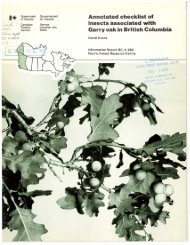
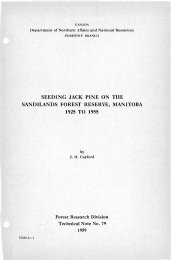
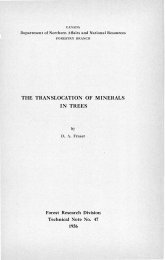
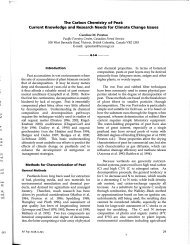



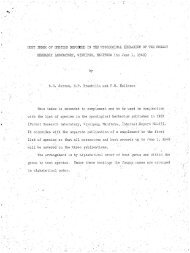
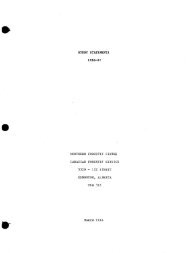
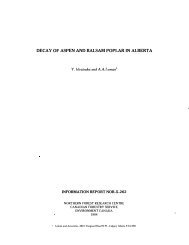
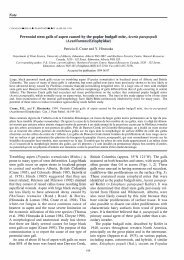
![Po],rell](https://img.yumpu.com/11946277/1/190x231/porell.jpg?quality=85)
